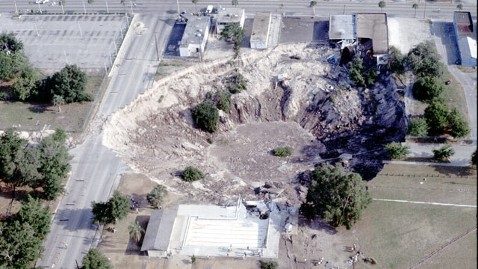How Sinkholes Can Develop
There are a variety of factors that cause the development of sinkholes like the one that formed late Thursday night in Seffner, Fla.
Hillsborough County, where Seffner is situated, is part of an area in Florida prone to sinkholes, with insurance claims associated with them more than doubling between 2006 and 2009, according to a Florida Senate report.
"The area between Tampa and Orlando was a big agricultural area," Randall Orndorff, geologist with the U.S. Geological Survey, told ABC News. 'There's been a lot of development there and rainwater that used to percolate through the soil into the subsurface is now running off into either culverts or ditches, to storm drains."

Image credit: AP Photo
Other states prone to sinkholes are Alabama, Pennsylvania, Missouri, Kentucky, Tennessee and Texas, according to the U.S. Geological Survey.
Here are some of the factors that can cause sinkholes:
1. Water. Sinkholes are typically caused when a deposit of earth comprised of a soluble rock, such as limestone, salt or gypsum, is exposed to water and dissolves. Areas that have large deposits of soluble rocks are particularly vulnerable. Once the water leaches away, it leaves a void underground that can cause the ground on the surface to collapse under its own weight. Sometimes, sub-surface water can help keep surface soil in place.
2. Disturbance of sub-surface soil. When sub-surface rocks develop a void because of erosion, surface soil gradually seeps down to fill the cavity. As this occurs, the cavernous hole moves upwards until it is very near to the surface, resulting in a collapse and subsequent sinkhole.
3. Humans. Human activity can also be a factor in the development of sinkholes. Whenever groundwater levels change - sometimes as a result of construction, development practices or groundwater pumping - sinkholes can form. The weight of a manmade construction, like a house, can expedite the formation of a sinkhole, adding extra weight that causes the surface soil to collapse. Additionally, a water main or sewage system bursting in an area where the base rock is soluble can also cause sinkholes.
"The human-induced aspect speeds up the process," said Orndorff. "We see water mains or sewers in large cities. As the infrastructure deteriorates, collapses can occur."
Your home and the area you live in can offer clues about the possibility of sinkholes.
Telltale signs are pavement or floors that have become uneven, or a stair step pattern of cracks appearing on the wall of a building. Sagging or slumping trees or fence posts can be another indicator, as well as pools of water forming where they have not previously.
"If you already live in an area with a history of sinkholes, we don't yet have a good geo-physical method, sort of like an MRI, that can find voids in the earth," said Orndorff. "At the same time, we have entire cities, like Nashville or St. Louis, who are sitting on these areas, so sometimes it's a matter of engineering."